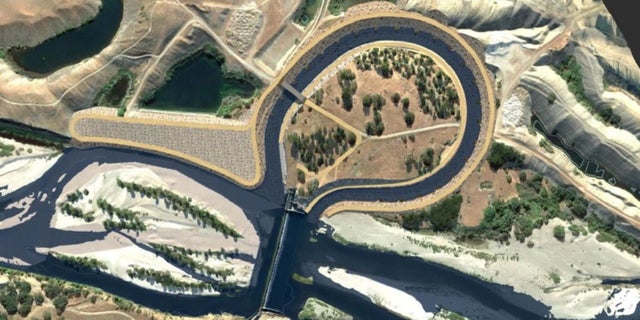California officials on Tuesday announced a $60 million effort to open the Yuba River so salmon and other threatened fish species can get around a Gold Rush-era dam that has cut off their migration.
The project calls for the building of a fishway around the century-old dam to open 12 miles for the fish.
“Despite a more modest deficit, we’re holding the line on projects like these and we’re moving them forward,” Gov. Gavin Newsom said in front of the dam Tuesday during a news conference attended by other state, local and federal officials.
BIRD ATTACKS DRONE MID-AIR IN SHOCKING VIDEO
A rendering of a planned California fishway that will allow fish to reach healthy habitat around a Gold-Rush era-dam in the Yuba River. (Office fo Gov. Gavin Newsom)
The project was approved by the California Department of Fish and Wildlife and other state agencies.
Tuesday’s announcement will affect the Daguerre Point Dam near the Northern California city of Marysville. The federal government first built the dam in 1906 as a way to stop the seemingly endless flow of debris left over from hydraulic mining during the height of the Gold Rush of the mid 1800s.
The project will cost $60 million, with $30 million coming from the state and the rest from the Yuba River Water Agency. The funding has been a priority despite the state facing a nearly $32 billion budget deficit, Newsom said.

Gov. Gavin Newsom, state, local and federal officials announced agreement Tuesday to restore the Yuba River. (Office of Gov. Gavin Newsom)
The dam is mostly underwater, allowing the water to spill over the top of it while holding back a mountain of sediment. But it also blocks three species of fish from migrating up the river to spawn — spring-run Chinook salmon, steelhead trout and green sturgeon.
In 2012, the National Marine Fisheries Service declared the dam posed a threat to the survival of those fish species.
“Within a few decades, Gold Rush mining created impacts that have lasted over 150 years,” said Willie Whittlesey, general manager of the Yuba Water Agency. “We’re finally taking action to reverse those impacts.”

A view of what the fishway will look like after the $60 million project is completed. (Office of Gov. Gavin Newsom)
CLICK HERE TO GET THE FOX NEWS APP
The salmon, trout and sturgeon are born in the cold, freshwater rivers filled with snowmelt from the Sierra Nevada.
Once the fish hatch and grow big enough, they migrate through the river delta to the Pacific Ocean. They then return to the rivers, swimming upstream to where they were born to lay more eggs.